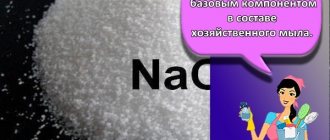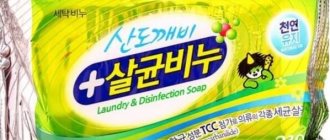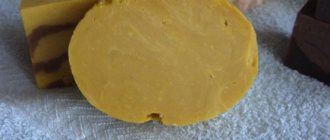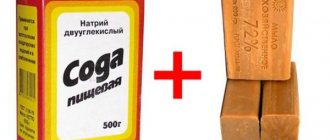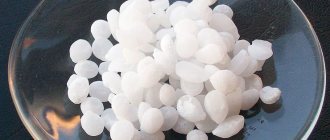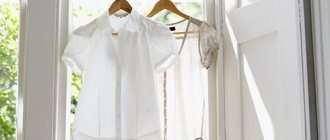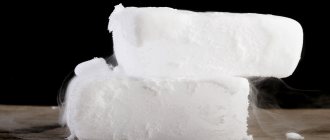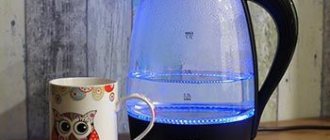There is soap in every home. Most often it is used for face and body care, or for washing hands. However, there is another area of its application - washing things.
Sometimes it copes with complex stains better than expensive powders and gels. Read the article about what soap you can use for washing and how to make the right choice.
History of laundry soap
The earliest mentions of detergent products similar to today's soap date back to the 28th-29th centuries BC. e. Records about them are found in scrolls, treatises and letters of the Egyptians, ancient Romans, and Gauls. At the beginning of the 17th century, soap makers appeared in Europe, and in the Russian Empire, tar soap was invented, which has an unpleasant, pronounced odor, but copes with fleas and other insects.
A bar weighing 180-200 grams with a 72% stamp has been produced in the USSR since the thirties of the 20th century; its recipe was taken from the Parisian scientist Michel Eugene Chevreulier and then improved. The original recipe contained two types of animal fats, while the new formula already had three types of main components: alkali metals and edible gelatin were added to the fats.
Post-war shortages sparked interest in this economical detergent. It was used as an alternative when bathing children, rinsing hair, and treating skin diseases.
Effect on clothing and water
Using laundry soap for laundry has both positive and negative sides. On the one hand, there is complete confidence in the composition, I am pleased with the financial accessibility, as well as the result. But on the other hand, when using soap, the washing machine may suffer, because a coating remains on its walls, which eventually settles on the working parts, they become clogged and a breakdown occurs, followed by expensive repairs. Also, natural laundry soap can harm the fabrics from which clothes are made, especially delicate ones.
You can reduce the negative impact of laundry soap on clothes and cars by following simple rules:
- No more than 30 grams of soap should be consumed per 10 liters of water;
- The maximum washing water should be 70 degrees, and it is better not to raise it above forty.
The type of water is also of great importance. If it is hard, then approximately 30% of the total amount of soap will be used to soften it. But you can further soften it with soda.
There is a simple way to find out if your water is hard. To do this, you just need to lather the soap under running water. The harder it is, the worse it will lather.
72% what does this mean?
Each piece of domestic laundry soap is stamped with the manufacturer's stamp and numbers indicating the percentage. These numbers represent the percentage of fatty acids: the higher the value, the better the cleaning power.
The direct cooking method allows you to obtain a product containing no more than 60% fat content. A more complex production method, which includes scraping out table salt, makes it possible to produce soap lye and “core” soap, which is subsequently boiled as a briquette with 72% fat content.
What types of clothes are best washed with soap?
You can wash almost any item with soap. It is not recommended to wash with soap:
- woolen items;
- heavily soiled items requiring deep cleaning and disinfection.
It is better to wash with soap:
- children's things, especially things for newborns, because soap does not dry out or irritate children's skin; clothes of newborn children are washed only with baby soap or special baby powders based on natural soap like Chistown Children without phosphates and other chemicals;
- things of people prone to allergies; sometimes replacing washing powder with soap or soap powder when washing completely relieves people of allergies;
- It is better to wash lace underwear, handmade items, made from delicate fabrics, with various inserts by hand in a warm solution of natural soap.
Production methods
Preparing a soap product and putting it on the market are production processes that in modern factories can be carried out using two methods: direct or indirect.
- The direct method is rooted in distilling the original ingredients until a soap glue appears. The resulting mass is brought to a solidified consistency, then cut into bars and sold to the market for essential goods. This method produces soap of a high quality standard with a low fat content.
- The indirect technique involves salting out soap paste, or grinding with a saline solution. The process ends with the appearance of soap lye and soap core. The latter contains many times more saturated fatty acids than the adhesive.
To obtain a product of appropriate quality, the raw material is distilled a second time. For natural soap with a fat content of 72%, the salting out process is carried out at least 2 times. Various catalysts help speed up the process.
What is the best way to use soap for washing?
Some general tips on how to best wash with soap:
- for washing it is better to prepare a soap solution, but several small items can be washed directly under the tap using a bar of soap;
- Items with fresh dirt are best suited for washing with soap;
- if the stains are old, it is better to soak the items in a soap solution before washing;
- if the tap water is hard, it is better to soften the washing water with soap, adding a little vinegar or citric acid; the acid also helps preserve the color of items after washing.
Chemical composition of laundry soap 72 percent according to GOST USSR
The technical characteristics of laundry soap, developed by Soviet craftsmen and today existing in Belarus, the Russian Federation, Uzbekistan, Tajikistan and Ukraine, were approved and recorded by GOST 30266-95. The document fixes the mandatory inclusion in the composition of not only natural fatty acids extracted from fats of animal origin. It stipulates the mandatory presence of auxiliary components (potassium and sodium salts, alkalis and plant substrates) and the absence of foreign additives.
During the Soviet era, buyers did not know what laundry soap was made of, but saw its unpresentable appearance. Therefore, there was a myth that the detergent was boiled from the bones of captured stray cats and dogs. The information was not true. Firstly, the lard and fat of these animals does not contain components of a quality suitable for soap making. Secondly, their amount of fat is minimal, which would make the cooking process unprofitable for the manufacturer. This is why, despite rumors, laundry soap was not made from dogs and cats.
The block, made according to GOST, is painted in a light brownish or ocher shade. Unlike toilet soap, a bar used for household needs does not contain fragrances and is completely odorless. A specific aroma in the air appears only when hot water hits the finished piece.
Judging by the inscription on the label, manufacturers advise storing the product for no more than 12 months (in other words, the shelf life is 1 year).
How to prepare liquid laundry soap
The most effective and simplest way to prepare liquid soap for a washing machine:
- Grate 100 g of soap.
- Pour the finished shavings into a metal container (it’s better if it’s an unnecessary pan), pour hot water (1 l).
- Place on low heat. Stirring frequently until completely dissolved. Do not let the mixture boil.
- In a second container, dilute four tablespoons of baking soda. Add the finished mixture to the soap mass.
- Mix thoroughly until smooth and allow the liquid to cool.
Using these tips, you can not only prolong and make the life of your home help easier, but also save yourself and your family from the aggressive components of washing powders.
What is laundry soap made from in modern production?
Genuine laundry soap in modern Russia is produced without deviations from the Soviet recipe. The composition contains sodium or potassium salt, as well as fatty acids. All ingredients have special characteristics and cleaning properties.
Animal fats
The main component of laundry soap 72 is animal fats. Typically, manufacturers use pork or beef fat, but they can be replaced with fatty layers of marine fish.
Sodium
Each briquette contains a small amount of sodium. But this silvery-white metal is a caustic alkali, which even in small quantities will quickly remove stubborn and old stains when washing clothes, curtains, carpets and other items.
Fresh water
An essential component of any piece product is clean running water, which is involved in the process at all stages of product production.
White Porcelain Clay Kaolin
Clay for the production of soap bars is taken in small quantities, but even its small presence softens the aggressive alkaline effect on human hair and skin.
Fatty acid
To create a natural product, two acids are taken:
- Lauric. Due to its presence, the briquette begins to foam well and remove contaminants even in cool water.
- Palmitic. Makes the wash piece harder.
The higher the percentage of unsaturated acids in the laundry soap, the more ointment-like the consistency.
Other additives
Sometimes manufacturers include acceptable additives in the standard composition of a brown bar. Among them are the following components:
- Soap stocks are substances formed during the purification of fats with alkaline solutions. The higher the quality of the soap stock, the harder the soap briquettes will be. Low quality ingredients will manifest themselves in the form of an unpleasant persistent odor and color of the detergent.
- Salomas is a hard fat common in the production of spreads.
- Rosin is an element often added to low-grade products. This ingredient will help improve foaming performance and dissolution in ice water.
- Caustic soda. Needed for saponification of fats.
- Soda ash serves the same purpose as the previous one. Its other name is sodium carbonate.
A fairly inexpensive and widely available admixture is sometimes secret ingredients - sodium silicates, which increase the cleaning ability of the product in hard water.
The existing GOST allows the inclusion of all these components, including sodium silicate, in a product with a fat content of 72%. Other fatty raw materials can be added in production if there is a safety certificate.
Which soap is better?
You need to figure out how laundry soap with different percentages of fatty acids differs in its qualities.
Soap 72.5% has the best cleansing properties. But it also has a high pH (11-12), so it dries out the skin greatly. If you frequently use the product without wearing protective gloves, the skin on your hands will quickly become dry and cracks may appear. Also, dark laundry soap has a more pronounced smell.
Soap 69% and 64% are slightly less effective and less aggressive. If you need to remove old, greasy stains, remove stubborn dirt, or whiten laundry, you should choose dark soap 72.5%.
64% soap can be used for cosmetic purposes. It is softer and does not dry out the skin as much. You can use it to wash your hair to get rid of dandruff, wash your face, and treat small wounds and scratches. Laundry soap foam in combination with baking soda is used for home peeling procedures.
Attention! Do not use laundry soap to bathe children; their skin is too delicate. Products with a neutral pH value are suitable for children.
Much depends on the storage conditions of the product. Soap should be stored in a dry, ventilated area at a temperature of at least -5°C. Air humidity should not exceed 75%.
The bar that is already in use should be placed in a soap dish with a tray to allow the water to drain. This will keep it dry and firm and not get soggy. If the air in the room is too dry, the soap, on the contrary, may crack.
Which soap color should you choose: dark or light?
On store shelves you can find white, light brown (mustard) and dark brown briquettes with the imprint 72. Only dark-colored bars can be considered natural: they contain a large amount of fatty acids, but because of them the product has a characteristic pungent odor.
The lighter the soap, the more additives it contains - flavorings.
In addition to these additives, an all-white cleaning product also contains other chemical ingredients in its composition, so it cannot be considered completely natural.
How to choose a good one?
Laundry and baby soap are best suited for washing clothes. Preference should be given to a product without additives whose origin is unknown.
For processing things they do not use:
Handmade soap.- Products with insoluble particles. They can be added to the bar for decoration or to provide a scrub effect.
- Soap with essential oils. They leave stains on things.
- A product with a complex chemical composition. For allergy sufferers, such household chemicals are strictly contraindicated.
The solid form of release has a more natural composition, it contains less dyes, preservatives and fragrances.
Harm or benefit?
Like any other product, brown bar has its advantages and disadvantages. At the same time, the detergent has many more advantages:
- low price,
- simplicity, efficiency and economy,
- multifunctionality,
- natural origin and harmlessness,
- absence of harmful components and synthetics in the composition,
- can be used at any age,
- no contraindications,
- simple composition, so you can prepare the product yourself.
The disadvantages of laundry soap include:
- ability to dry out skin and hair (ph 11-12),
- an unpleasant odor that is difficult to get rid of without using expensive household chemicals,
- Possible components contained in the product may cause an allergic reaction.
10 useful properties
Bar soap has a lot of useful properties that will find use in any home. The following qualities of the detergent stand out:
- antiseptic effect;
- antibacterial effect on any wounds, scratches and cracks;
- anti-inflammatory and protective properties;
- reduction of swelling;
- disinfectant effect;
- neutralization of unpleasant symptoms of insect bites, abscesses, household burns, bruises, wounds, scratches;
- acceleration of healing processes;
- prevention of acne formation and skin irritation after depilation;
- elimination of dandruff and restoration of hair structure;
- getting rid of calluses, cracks and corns.
Contraindications
Since 72% laundry soap, made in accordance with GOST, is a natural and healthy product, it does not have many contraindications. The main one is the development of an allergic reaction with regular and systematic use.
Frequent use of the product for cosmetic and hygienic purposes is not suitable for people with dry skin and dry hair. The product will aggravate the situation, reduce humidity and dry out the skin and make hair brittle.
Types and scope of application
A modern manufacturer presents laundry soap of different consistencies. It can be found in the form of bars, liquid and even powder.
I would like to pay special attention to liquid laundry soap. The low price and ease of use have allowed this product to become very popular among housewives.
However, contrary to the manufacturers’ statements about the identity of its composition with solid species, this is not entirely true.
Note!
The specifics of production and the components of real laundry soap do not allow this product to be produced in liquid form!
Pay attention to the composition of such a detergent, and you will be convinced that apart from the name with a solid analogue, they have nothing.
The basic components of liquid laundry soap are various surfactants, usually toxic. Indeed, it does an excellent job of removing various kinds of dirt on fabrics and grease on dishes, but it is far from an environmentally friendly product. Using it, you are not immune from the occurrence of an allergic reaction, as after using any other synthetic detergent. And, of course, you shouldn’t wash children’s clothes with such “laundry” soap.
Methods of use in everyday life
The main advantage of natural soap is its composition: 72% soap bar is brewed exclusively from environmentally friendly and natural ingredients. Hence its hypoallergenicity and absolute harmlessness to the body. Housewives use brown detergent not only for its intended purpose, but also use it in everyday life for other purposes.
Wash:
- suitable for bedding and clothing for newborns and babies, adds whiteness, removes yellowness;
- has a beneficial effect on wool and other delicate fabrics;
- removes old stains on clothing, including sweat, deodorant, tea and coffee stains. Instructions: soak things in a soapy solution for 1-2 hours (it is advisable to thoroughly dissolve the soap particles);
- used as a conditioner. After it, the products regain their original softness and former splendor.
Important! Use in a washing machine is not recommended. It can be dangerous and lead to breakdown due to the formation of invisible deposits on the walls of the drum, in the washing compartment of the machine. Use recommended washing modes and washing powders. The use of laundry soap in the dishwasher is also not recommended.
Cleaning:
- washes dishes until they shine after greasy food (you can soap the sponge and clean it even in cold water). To wash dishes with a thick layer of fat, you will need to soak them in the sink and leave them to soak overnight, rinse them thoroughly after washing;
- acts as a universal cleaning product (cleans plastic, ceramic, stone and metal surfaces);
- how long cutting boards (including wooden ones) and kitchen knives are soaked after cooking meat or fish depends on the degree of contamination;
- soap solution is suitable for watering home and garden plants;
- will do an excellent job of removing stubborn dirt on various surfaces - tiled floors, tiles, laminate, linoleum;
- Soap shavings help destroy insect pests on plants and soil, and are a fertilizer for fruit trees, cultivated vegetables and fruits.
Hygiene and cosmetics:
- rinses hair efficiently, restoring its structure and eliminating dandruff;
- mixture 1 tbsp. l. soap shavings and 1 tsp. salt fights acne and acne;
- fights skin irritation after depilation on sensitive areas;
- Great for processing personal hygiene items (combs, washcloths, toothbrushes, manicure and pedicure tools);
- significantly reduces swelling;
- water foam with soap allows you to make high-quality facial peeling;
- baths of soap, baking soda and salt get rid of calluses and help with corns and cracks on the feet.
Can it be added to an automatic washing machine?
Soap can be added to the washing machine, but in order not to harm household appliances, you need to adhere to the following recommendations:
- Preference is given to liquid soap.
- Be sure to take tissue type into account to adjust the dose. For example, wool contributes to the formation of abundant foam. Therefore, such products will require less detergent.
- To prevent fatty acid salts from settling on machine parts, you should not wash things with soap too often.
- After completing the cycle, it is recommended to rinse the drum with vinegar water.
The detergent composition for the washing machine can be prepared from a bar. It is grated and dissolved with hot water until a homogeneous mass is formed. The resulting composition is poured into the liquid powder compartment.
With your own hands
Liquid laundry soap is available on store shelves, but if you wish, you can make it yourself. It is more convenient for washing dishes. Excellent against mold in the bathroom, has an antifungal effect, less time spent on soaping. As ingredients, use a whole 72% bar or soap, a tablespoon of honey and glycerin (you can add liquid vitamin E instead), a few drops of essential oil to your taste (it will give a pleasant aroma). Usually they take citrus (lemon or orange), tea tree, eucalyptus or rose oil. For convenience, the soap must first be softened by placing it in a warm place. Then grate on a fine grater, mix with a glass of boiling water and beat with a blender until smooth. Let stand for 15 minutes, pour in the remaining ingredients, and beat again. It is then recommended to pour the liquid substance into a suitable container with a dispenser or a plastic bottle and store at room temperature.
If you boil soap shavings in a half-liter saucepan, stir the resulting liquid until a homogeneous mass is obtained, cool and pour in a tablespoon of vodka and 50 ml of glycerin, the result will be a concentrated gel.
Weaknesses and strengths
Soap has a wide range of uses. It is often used as a dishwashing detergent or hand wash. Its main advantage is its disinfectant and antiallergic properties. It also perfectly removes stains of organic origin and is very economical to use. The disadvantage is that soap cannot remove inorganic contamination.
Grated baby soap
Use in folk medicine
Product elements 72%, which contain alkalis, dissolve dirt and have an antimicrobial effect. That is why in medicine it is used instead of an antiseptic: the detergent inhibits the appearance of inflammatory processes of various etymologies and destroys pathogenic microbes.
Viral and gynecological diseases can be treated, so in most maternity hospitals the floors are rubbed with soapy water. Thin “suppositories” carved from bar soap and placed in the rectum are an effective laxative for pregnant women and the elderly. Washing with soapy water can also cure candidiasis and prickly heat.
Surgeons wash their hands with 72% laundry soap and wait until it dries: in this case, the risk of infection of the doctor during surgery will be reduced to zero. The probability is low even if the specialist does not have sterile gloves on his hands.
Traditional medicine recommends using this miracle remedy in the following cases:
- With a dog bite. You need to act like this: wait until the blood flows out of the wound, and then apply gauze moistened in a soap solution to the damaged area and treat it generously.
- Fights infection at the first symptoms of a runny nose. Dip a cotton swab in soapy water and apply it to your sinuses. During the day it should be repeated, you can lubricate your nose 2-3 times.
- For foot fungus. Thoroughly wash the affected area with a brush and natural soap, then disinfect the skin with iodine.
- For burns. Immediately after an injury, you should soap the damaged area and wait time to dry.
- For damage or problems in the mouth. Before going to bed, regularly disinfect your toothbrush with soapy water and do not rinse it until the morning to completely disinfect it. Duration of use: 1-2 weeks.
- For swelling and bruises. The procedure is as follows: dilute the bar in water (first bring it to a boil), and then rub the resulting solution on the injured area. Repeat several times a day.
What cosmetologists do not recommend
In order not to cause harm to the body, cosmetologists do not advise :
- frequently use laundry soap on the body to remove the fatty protective layer along with the dirt;
- leave foam on mucous membranes;
- wash your face more than twice a week;
- use the product for household purposes without gloves to protect the skin of your hands from peeling and loss of elasticity.
Attention! For problem skin, wash only oily areas with a solution of laundry soap, since in addition to dryness, you can get chemical burns that turn into dermatitis.
After completing hygiene procedures, apply a moisturizer. If foam gets into the eyes, rinse the mucous membrane thoroughly. Soap is contraindicated in case of individual intolerance, thin, sensitive and dry skin.
Laundry soap, like other products, has both benefits and harm. You just need to follow the rules of use and everything will be fine!
Review of the best manufacturers
In 2020-2021, the following companies are considered the main producers of laundry soap of suitable quality in Russia:
- "NZhMK" (Nizhny Novgorod). The company produces solid and liquid laundry soap. The first industrial production was launched on the territory of the oil mill in 1905.
- "Nevskaya cosmetics" (St. Petersburg). Made from natural fats and oils. Bonus: he is the winner of the “Test Purchase” program on Channel 1 (broadcast on December 15, 2017).
- PKK "Vesna" (Samara). The concern sells a classic detergent suitable for washing clothes, household cleaning, and removing dirt from hands and body.
- "Freedom" (Moscow). The company supplies high-quality products that do not have a harmful effect on the environment, do not irritate the skin and do not cause allergies.
- "EFKO Cosmetic" (Voronezh). Each production cycle is carried out strictly according to the current GOST and traditional technologies.
- "Stork" (St. Petersburg). The products produced by this company have soft foam. The products contain glycerin, which softens the skin of the hands and is suitable for delicate children's skin. When placed in water, the product does not get wet, and during long-term storage it does not crack.
- "Fat plant" (Saratov). The company sells excellent soap that easily removes stains even in hard water.
The online consumer community has its own additional popularity rating for household soap brands of 72%. It included three companies, only one of which is of Russian origin:
- Sodasan (Germany) - distinguished by the rapid removal of difficult stains;
- SARMA (Russia) - quoted for its safe composition;
- DURU CLEAN&WHITE (Turkey) - included in the rating for the ideal proportion of cost and product quality.
What harm does laundry soap cause to human skin?
Despite the antimicrobial, cleansing properties of the hygiene product, regularly .
Frequently washing your body with laundry soap leads to sad consequences. Laundry soap dries the skin, weakens the barrier properties of the protective layer, corroding it with alkaline components, disrupting the acid-base balance.
The epidermis becomes thinner and becomes vulnerable to mechanical damage due to temperature changes and burns when exposed to ultraviolet radiation.
If you wash a child with laundry soap, his or her incompletely formed local immunity will be weakened. Infection can penetrate through the delicate baby skin.
Women who use this product for a long time look older than their age due to the formation of early wrinkles, redness, irritation, and dehydration of the skin. A feeling of tightness and microcracks appears.
Scientific research has proven that, contrary to the belief that soap cures thrush, the product is not suitable for washing. The detergent temporarily suppresses the symptoms, but will not cure the disease.
Pharmacy products effectively combat candidiasis. Hygienic procedures for the intimate area are performed using specially designed products.
Laundry soap dries out the mucous membrane, disrupts the microflora, and kills lactic acid bacteria.
